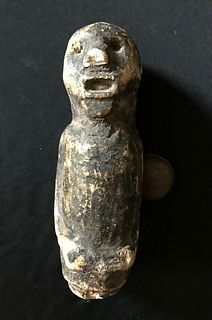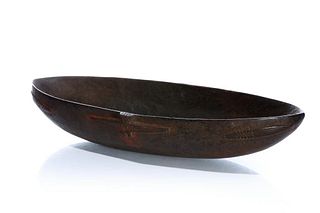Mississippian Monolithic Stone Axe - CIRAM Tested
Lot 84a
About Seller
Artemis Fine Arts
686 S Taylor Ave, Ste 106
Louisville, CO 80027
United States
Selling antiquities, ancient and ethnographic art online since 1993, Artemis Gallery specializes in Classical Antiquities (Egyptian, Greek, Roman, Near Eastern), Asian, Pre-Columbian, African / Tribal / Oceanographic art. Our extensive inventory includes pottery, stone, metal, wood, glass and textil...Read more
Categories
Estimate:
$13,000 - $19,500
Absentee vs Live bid
Two ways to bid:
- Leave a max absentee bid and the platform will bid on your behalf up to your maximum bid during the live auction.
- Bid live during the auction and your bids will be submitted real-time to the auctioneer.
Bid Increments
| Price | Bid Increment |
|---|---|
| $1 | $25 |
About Auction
By Artemis Fine Arts
May 1, 2025
Set Reminder
2025-05-01 10:00:00
2025-05-01 10:00:00
America/New_York
Bidsquare
Bidsquare : Fine Antiquities, Asian, Ethno, Fine Art
https://www.bidsquare.com/auctions/artemis-gallery/fine-antiquities-asian-ethno-fine-art-19334
Showcasing an extraordinary array of artifacts and art, including Egyptian, Greek, Roman, Etruscan, Near Eastern, Asian, Pre-Columbian, Native American, Tribal, Oceanic, Spanish Colonial treasures, fossils, fine and visual arts, and more! All ancient items are ethically sourced and legally available for sale. Enjoy the ease of in-house shipping for a seamless experience! Artemis Fine Arts info@artemisfinearts.com
Showcasing an extraordinary array of artifacts and art, including Egyptian, Greek, Roman, Etruscan, Near Eastern, Asian, Pre-Columbian, Native American, Tribal, Oceanic, Spanish Colonial treasures, fossils, fine and visual arts, and more! All ancient items are ethically sourced and legally available for sale. Enjoy the ease of in-house shipping for a seamless experience! Artemis Fine Arts info@artemisfinearts.com
- Lot Description
United States, Natiive American, Mississippian, southern US, ca. 800 to 1200 CE. This superb and incredibly rare example is a ceremonial axe of elongated form with rounded "blade" that was created to model an actual axe with portion of the blade extending through the wooden haft. Drilled for suspension, it is a bit hard to believe someone might want to wear this around their neck so it is much more logical that it was worn on the wrist with a short cord and danced during ceremonial rites. Because of its rare form it was tested by CIRAM Lab in New York and France. CIRAM is one of the only labs in the world that is respected and trusted for its ability to test stone. Size: 14.5" L x 7.5" H (36.8 cm x 19 cm)
The original CIRAM report will accompany the piece. For similar examples see Mississippian monolithic axe, Gilcrease Museum 61.18910, and Stone monolithic axe from the Wilbanks site, Georgia. Smithsonian Institution, Museum of Natural History, Washington, DC A317614
Provenance: private Lumberton, Texas, USA collection, acquired before 2000
All items legal to buy/sell under U.S. Statute covering cultural patrimony Code 2600, CHAPTER 14, and are guaranteed to be as described or your money back.
A Certificate of Authenticity will accompany all winning bids.
We ship worldwide and handle all shipping in-house for your convenience.
SHIPPING EXCEPTIONS: Due to customs clearance issues, we are unable to ship to Germany, Switzerland and Australia. If you live in Germany, Switzerland or Australia, you will need to provide an alternate shipping destination, or we will not be able to complete your purchase. In addition, please note that we are unable to ship ancient items back to the original country of origin (Egyptian to Egypt, Greek to Greece, etc.)
PAYMENT EXCEPTION: Unless a known customer of Artemis, payment for all gold / precious metal / gem lots must be made via Bank Wire Transfer or Certified Bank Check/Money Order, no exceptions.
#183673Intact and excellent with one stable surface crack. According to CIRAM, this piece has been polished in modern times but is an ancient object.Condition
- Shipping Info
-
All shipping is handled in-house for your convenience. Your invoice from Artemis Gallery will include shipping calculation instructions. If in doubt, please inquire BEFORE bidding for estimated shipping costs for individual items.
-
- Buyer's Premium



 EUR
EUR CAD
CAD AUD
AUD GBP
GBP MXN
MXN HKD
HKD CNY
CNY MYR
MYR SEK
SEK SGD
SGD CHF
CHF THB
THB















